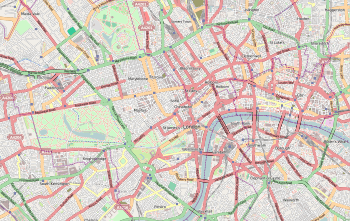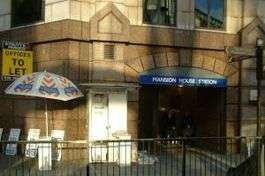Mansion House tube station
| Mansion House | |
|---|---|
|
Entrance on Cannon Street | |
 Mansion House Location of Mansion House in Central London | |
| Location | Queen Victoria Street/Cannon Street |
| Local authority | City of London |
| Managed by | London Underground |
| Number of platforms | 3 |
| Fare zone | 1 |
| OSI |
Blackfriars Cannon Street |
| London Underground annual entry and exit | |
| 2012 |
|
| 2013 |
|
| 2014 |
|
| 2015 |
|
| Key dates | |
| 1871 | Opened as terminus (MDR) |
| 1872 | Started "Outer Circle" (NLR) |
| 1872 | Started "Middle Circle" (H&CR/MDR) |
| 1884 | Extended east, "Inner Circle" completed |
| 1900 | Ended "Middle Circle" |
| 1908 | Ended "Outer Circle" |
| 1949 | Started (Circle line) |
| 1989 | Closed for rebuilding |
| 1991 | Reopened |
| Other information | |
| Lists of stations | |
| WGS84 | 51°30′44″N 0°05′39″W / 51.5122°N 0.0941°WCoordinates: 51°30′44″N 0°05′39″W / 51.5122°N 0.0941°W |
|
| |
Mansion House is a London Underground station in the City of London which takes its name from the nearby Mansion House (although Bank station is actually closer to it). It opened in 1871 as the eastern terminus of the Metropolitan District Railway. Today, Mansion House is served by the Circle and District lines. It is between Blackfriars and Cannon Street stations and it is in fare zone 1. The station is located at the junction of Queen Victoria Street and Cannon Street.
Mansion House is a sub-surface station with three platforms. The westbound platform, number 1, and the eastbound platform, number 3, are shared by both the Circle and District lines. A third platform, number 2, is for terminating eastbound trains, however it is rarely used as most services continue and terminate at Tower Hill.
History
_p070_-_Mansion_House_underground_station.jpg)
Mansion House station was opened on 3 July 1871 by the Metropolitan District Railway (MDR, now the District line) when the company extended its line eastwards from St. Paul's station (which is now named Blackfriars). Mansion House became the new eastern terminus of the MDR.
The MDR connected to the Metropolitan Railway (MR, now the Metropolitan line) at South Kensington and, although the two companies were rivals, each company operated its trains over the other's tracks in a joint service known as the "Inner Circle".
On 1 February 1872, the MDR opened a northbound branch from its station at Earl's Court to connect to the West London Extension Joint Railway (WLEJR, now the West London line) which it connected to at Addison Road station (now named Kensington (Olympia)). From that date the "Outer Circle" service began running over the MDR's tracks. The service was run by the North London Railway (NLR) from its terminus at Broad Street (now demolished) via the North London Line to Willesden Junction, then the West London Line to Addison Road and the MDR to Mansion House.
From 1 August 1872, the "Middle Circle" service also began operations through Westminster running from Moorgate along the MR's tracks on the north side of the Inner Circle to Paddington then over the Hammersmith & City Railway (H&CR) track to Latimer Road, then, via a now demolished link, to the West London Line to Addison Road and the MDR to Mansion House. The service was operated jointly by the H&CR and the MDR.
From 1 March 1883, the District operated a service between Mansion House and Windsor, using Great Western Railway tracks from a junction installed just east of Ealing Broadway station, but it was unremunerative and ceased on 30 September 1885.[3][4][5]
On 10 October 1884, the MDR and the MR jointly opened the line eastwards to Mark Lane station (closed 1967), thereby completing the "Inner Circle".
In 1897 the MDR obtained parliamentary permission to construct a deep-level railway running between Gloucester Road and Mansion House, beneath the existing sub-surface line. This new line was to be an express route using electric trains to relieve congestion on the sub-surface tracks. Mansion House was to be the terminus of the express route, with platforms 71 feet (22 m) below the sub-surface ones.[6] No immediate work was carried out on the deep-level line, and the subsequent take over of the MDR by the Underground Electric Railways Company of London (UERL) and the resignalling and electrification of the MDR's routes between 1903 and 1905 meant that congestion was relieved without needing to construct the deep-level line. The plan was dropped in 1908.[7]

On 30 June 1900, the "Middle Circle" service was withdrawn between Earl's Court and Mansion House. On 31 December 1908 the "Outer Circle" service was also withdrawn.
In the 1920s Mansion House station's entrance was rebuilt to a design by Charles Holden. It featured a tall glazed screen with the Underground roundel similar to his station designs for the extension to Morden of the City & South London Railway (now the Northern line) opened between 1924 and 1926.
In 1949, the Metropolitan line-operated "Inner Circle" was given its own identity on the Tube map as the Circle line.
On 29 October 1989 the station was closed for the construction of a new entrance and for further renovation. It reopened on 11 February 1991.
Connections
London Buses routes 11, 15, 17, 23, 26, 76, 100, 172, 388 and 521 as well as heritage route 15H and night routes N11, N15, N21, N26, N76, N199, N550 and N551 serve the station.
References
- ↑ "Out of Station Interchanges" (XLS). Transport for London. May 2011. Archived from the original on 20 October 2012.
- 1 2 3 4 "Multi-year station entry-and-exit figures" (XLS). London Underground station passenger usage data. Transport for London. April 2016. Retrieved 3 May 2016.
- ↑ Demuth, Tim (2004). "1881-1890". The Spread of London's Underground (2nd ed.). Harrow: Capital Transport. pp. 8–9. ISBN 1-85414-277-1.
- ↑ Connor, Piers (1993). "The District Looks West". Going Green: The Story of the District line. Harrow Weald: Capital Transport. pp. 14, 16. ISBN 1-85414-157-0.
- ↑ Day, John R. (1963). "The Metropolitan District and the Inner Circle". The Story of London's Underground (1st ed.). Westminster: London Transport. pp. 24–25.
- ↑ Badsey-Ellis, Antony (2005). London's Lost Tube Schemes. Capital Transport. pp. 70–71. ISBN 1-85414-293-3.
- ↑ Badsey-Ellis, Antony (2005). London's Lost Tube Schemes. Capital Transport. p. 220. ISBN 1-85414-293-3.
External links
| Wikimedia Commons has media related to Mansion House tube station. |
| Preceding station | Following station | |||
|---|---|---|---|---|
| Circle line | ||||
| District line | towards Upminster |
|||
| Abandoned plan | ||||
| District line Deep-level route (1898-1908) | Terminus | |||
